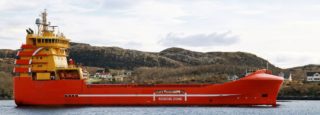-
Wärtsilä tests pave the way for ammonia as a future marine fuel
Date posted:
-
-
-
Post Author
Philip SharmanIFRF Director
-

The Marine Division of Finnish company Wärtsilä Oyj Abp (which trades internationally as Wärtsilä Corporation) is making great strides in developing marine engines that can use ammonia as a clean replacement for heavy fuel oil or diesel. “We get excited when it works according to our expectations,” says Kaj Portin, General Manager, Fuel & Operational Flexibility, Wärtsilä Marine.
The Wärtsilä scientists have good reason to be excited! Ammonia can be created with green energy and it contains no carbon so it doesn’t release carbon dioxide when it burns. It can be produced and used with no carbon emissions whatsoever: a huge advantage in the quest for a cleaner and more sustainable world.
Tried but not tested
The idea of using ammonia as a fuel is nothing new, but it has only been used in limited cases because there are major challenges to using it. “It doesn’t ignite very well and it burns slowly,” Portin explains. “You have to be careful with the temperatures and pressures to get it to work.”
There are two methods to use ammonia: see how much ammonia can be fed into a standard marine engine with small modifications, or design an engine that is optimised to operate with ammonia as its sole fuel. “If we modify the fuel, we can use it in our current engines,” Portin says. “For instance, maybe we can mix ammonia with LNG or diesel to get it to ignite.”
Wärtsilä scientists will continue tests using dual-fuel and spark-ignited gas engines. In 2022, they will begin working with ship owners on field tests.
Are fuel cells the way to go?
In addition to using ammonia in regular combustion engines, there is also another option: fuel cells. Using hydrogen in a fuel cell is a common idea, but ammonia can also be used, which is what is happening on a Norwegian ship. Eidesvik Offshore’s Viking Energy supply ship is the focus of a major clean energy project by the EU initiative ‘ShipFC’ and a consortium of companies including Wärtsilä. “Our role in the project is the development and delivery of the electronic and control equipment, as well as the systems required to store and distribute ammonia on board. We will also do integration and design work for the new energy system,” says Ingve Sørfonn, Manager Technology of Marine Electrical Systems at Wärtsilä.
Yara, the world’s biggest producer of ammonia, will produce ‘green’ ammonia for the ship – by doing so with hydro-electric power. When the Viking Energy launches, it will be the world’s first zero-emissions supply vessel using green ammonia as fuel.
Tapping into existing infrastructure
Fuel cells are an intriguing possibility, but the downside is that you need entirely new power plants. A better option would be to use clean fuel in existing machinery, which is why Wärtsilä scientists want ‘future-proof’ engines that can use the clean fuels of the future. It would also be better to use existing systems, which is another benefit of ammonia. “One major advantage of ammonia is that the infrastructure to use it already exists,” explains Cato Esperø, Sales Director, Wärtsilä Norway. “It is already shipped around the world in huge quantities.”
About 175 million tonnes of ammonia is currently produced annually. Its main uses are in fertilisers and in cleaning products. The know-how for using ammonia already exists – the challenge is to apply this knowledge in innovative ways.
The next big thing?
An ambitious idea to power ships with ammonia is the ‘Zero Emission Energy Distribution at Sea’ (ZEEDS) project. The ZEEDS idea is to build offshore hubs near busy shipping lanes that will produce, store and distribute clean fuel to vessels. Green ammonia will be produced with offshore wind parks while ships refuel at nearby stations. Partners in the project include Aker Solutions, Equinor, DFDS, Grieg Star, Kværner and Wärtsilä.
It is no wonder that ammonia is such a hot topic currently. The International Maritime Organization (IMO) and the UK’s Department of Transport have both expressed an interest in ammonia as a promising option in moving towards decarbonising shipping – see IFRF blogpost from March 2019 – and maritime heavyweights such as Samsung Heavy Industries, MAN Energy Solutions, Lloyd’s Register and MISC Berhad have launched an ammonia research project.
Wärtsilä is involved in a number of other ammonia-related projects: Carnival is studying the use of ammonia on their huge fleet of cruise ships; and Repsol wants clean energy produced by ammonia on their offshore platforms. “We are really excited about the opportunity ammonia as a fuel provides,” Esperø says. “In the near future, engines will be running with zero-carbon emissions. It will happen fast, we are doing something good for the future, and this will be great news for the whole world.”
Read more about Wärtsilä’s successful full-scale ammonia engine tests here.
